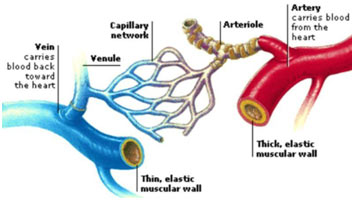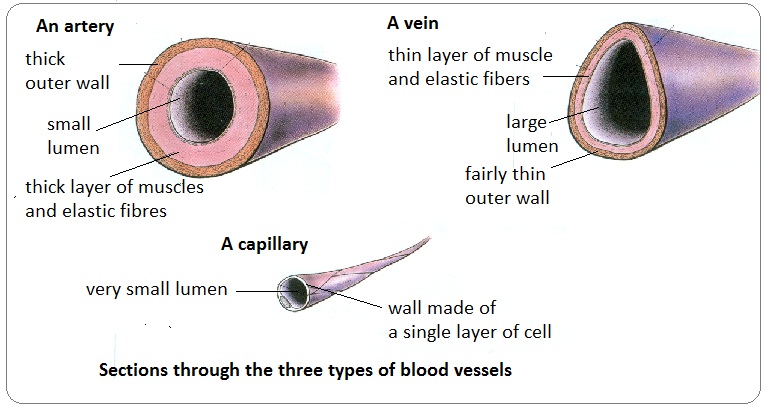Explain How Blood Pressure Differs Among Arteries Capillaries and Veins
Also because the blood pressure is small in the veins it is not going to be enough to return all that blood to the heart. Up to 24 cash back As blood enters capillaries from arterioles small arteries it slows down.

9 Difference Between Arteries Veins And Capillaries
The BP is low in the veins.

. Like all fluids blood flows from a high pressure area to a region with lower pressure. Blood flows rapidly between 400-500mm per second in the aorta and decreasing in arteries and arterioles. Explain how blood pressure differs in veins arteries and capillaries.
The thickness of the walls helps the arteries to withstand high pressure. Your body has a network of blood vessels over 60000 miles in length. Veins carry blood under low pressure from the organs and tissues back to the heart.
9 rows Arteries have high blood pressure. This amazing circulatory system includes three types of blood vessels arteries veins and capillaries. The vein walls have thinner muscular walls than arteries and have a wider internal diameter.
To begin with arteries have thicker and muscular. There is no pulse. Their walls are generally thicker than veins.
Thick middle layer of involuntary muscle to increase or decrease diameter. The flow of blood is slow in the veins. When an artery is cut the blood spurts out with very high pressure and can be rapid.
Because blood gushes from the heart to the artery under a very high pressure. On the contrary when a vein is cut blood flows from it very slowly and has more time to clot. Distinguish between systolic and diastolic pressure.
Inner layer of endothelium which reduces friction. All veins except the pulmonary veins carry deoxygenated blood. However the term blood pressure without any specific descriptors typically refers to systemic arterial blood pressurethat is the pressure of blood flowing in the arteries of the systemic circulation.
The blood carried by veins in addition to having little oxygen is also filled with carbon dioxide and various forms of cellular waste. This allows substances in the plasma as well as O2 from red blood cells to diffuse through the capillary wall into the surrounding tissues the capillary wall is thin and permeable. In fact the blood could easily back up or collect in these vessels.
In the capillaries and veins the blood pressure continues to decease but velocity. Blood returned to the heart. Blood pressure may be measured in capillaries and veins as well as the vessels of the pulmonary circulation.
The blood pressure BP differs based on the amount of blood which flows through the body at a given instant of time. Blood flow through the body is regulated by the size of blood vessels by the action of smooth muscle by one-way valves and by the fluid pressure of the blood itself. Blood flows in the same direction as the decreasing pressure gradient.
The blood pressure in the veins is thus much less. Blood supply at tissue level. The masculine walls help in vasoconstriction and vasodilation as well as in effective regulation of blood pressure.
The blood is certainly much less likely to burst through walls of the veins than arteries. Veins carry blood under low pressure from the capillaries and return the blood to the heart. Image result for Describe how blood pressure differs in the arteries capillaries and veins.
Arteries have a higher blood pressure than veins. There are no semi-lunar valves present in capillaries. Blood pressure results from the blood flow force generated by the pumping heart and the resistance of the blood vessel walls.
The veins return to the heart arteries come out of it. A layer of tissue on the outside a layer of smooth epithelial cells on the inside and a layer of muscle in between. In the capillaries and veins the blood pressure continues to decease but velocity increases.
One layer of endothelium with very small diameter. Their walls are thinner generally. In arteries waves of blood pressure or pulse due to heartbeat can be detected.
Blood moves away from the heart. Of arteries BP. Veins have thin and non-muscular walls.
Explore some of the changes to the cardiovascular system as the human body ages. Capillaries have no muscular walls. Veins transport blood to the heart and lungs at low pressure after receiving.
All arteries except the pulmonary arteries carry oxygenated blood. Pressure is a measure of the force that the blood exerts against the vessel walls as it moves the blood through the vessels. The wall is thick in arteries.
The blood pushes against the vessel walls and flows faster under this high pressure. Thin middle layer as pressure is reduced. The pressure of the blood flow in the body is produced by the hydrostatic pressure of the fluid blood against the walls of the blood vessels.
Veins have low blood pressure. Each plays an. The capillaries fulfill the function of bridge 4.
Liquid in the plasma also passes outThis forms tissue fluid bathing the cellsWaste products from the. The arteries have thicker smooth muscle and connective tissue than the veins to accommodate the higher pressure and speed of freshly pumped blood. The veins are thinner walled as the pressure and rate of flow are much lower.
The blood flow is rapid in the arteries. The blood flow is slow in capillaries. When the heart contracts it pumps blood out through the arteries.
The blood pressure is high in arteries. Explain how the lymphatic system interacts with the cardiovascular system. Capillaries are the link between arteries and veins and are very.
Blood pressure is related to the blood velocity in the arteries and arterioles. There is falling pressure in them. Write about your research and provide your Question.
Arteries have the highest BP. The blood pressure is always falling in capillaries. Arteries maintain blood pressure.
Of veins BP. There is no pulse. Arteries to capillaries to veins.
In the capillaries there is exchange of substances in veins and arteriesthere is none. The difference between arteries capillaries and veins. Therefore it is less severe than arterial blood loss.
Blood moves through the veins back to the heart where it enters in the right ventricle where it is then pumped into the lungs by the pulmonary artery and then back through the. Blood pressure is related to the blood velocity in the arteries and arterioles. Veins consist of three layers.
Veins carry blood back to the heart arteries carry blood away from the heart and capillaries connect arteries to veins. In addition veins are structurally different than arteries in that veins have valves to prevent the backflow of blood. The blood pressure of the arteries is much greater than that in the veins.

Arteries Veins And Capillaries Structure And Functions Biology Notes For Igcse 2014


Comments
Post a Comment